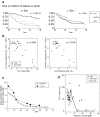D-Amino acids and kidney diseases
- PMID: 32112266
- PMCID: PMC7174270
- DOI: 10.1007/s10157-020-01862-3
D-Amino acids and kidney diseases
Abstract
D-Amino acids are the recently detected enantiomers of L-amino acids. Accumulating evidence points their potential in solving the long-standing critical problems associated with the management of both chronic and acute kidney diseases. This includes estimating kidney function, early diagnosis and prognosis of chronic kidney disease, and disease monitoring. Among the D-amino acids, D-serine levels in the blood are strongly correlated with the glomerular filtration rate and are useful for estimating the function of the kidney. Urinary D-serine also reflects other conditions. The kidney proximal tubule reabsorbs serine with chiral-selectivity, with D-serine being reabsorbed much less efficiently than L-serine, and urinary excretion of D-serine is sensitive to the presence of kidney diseases. Therefore, assessing the intra-body dynamics of D-serine by measuring its level in blood and urinary excretion can be used to detect kidney diseases and assess pathophysiology. This new concept, the intra-body dynamics of D-serine, can be useful in the comprehensive management of kidney disease.
Keywords: Biomarker; D-Amino acids; D-Serine; Early screening; Glomerular filtration rate; Kidney disease; Prognosis.
Conflict of interest statement
Grants received: TK (Shiseido Co., Ltd).
Figures



References
-
- Nagata Y, Akino T, Ohno K, Kataoka Y, Ueda T, Sakurai T, et al. Free d-amino acids in human plasma in relation to senescence and renal diseases. Clin Sci (Lond) 1987;73:105–108. - PubMed
Publication types
MeSH terms
Substances
Grants and funding
LinkOut - more resources
Full Text Sources
Other Literature Sources
Medical

